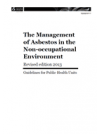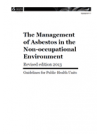- incorporating the recent epidemiological review carried out by the Ministry
- updating information on asbestos
- including an asbestos fire fact sheet
- changing the ‘Enforcement’ heading to ‘Health protection’
- clarifying the role and responsibilities of WorkSafe New Zealand
- highlighting the relevant sections in the Local Government Act that have been repealed by the Waste Minimisation Act 2008 (note specific reference to Health Protection Officers and Medical Officers of Health).
The guidelines provide guidance to PHUs on how to approach asbestos enquiries and how to manage interagency involvement. These measures will require cooperation and coordination at a local level by each agency and should involve formal agreements on how to proceed.
Properly applied, the guidelines will help to determine:
- the risk of an asbestos hazard
- appropriate advice on managing the risk, including appropriately communicating the risk.
Some public concern continues to be expressed about asbestos-cement products, which were used widely in New Zealand buildings until the mid 1980s. These products normally provide a matrix that binds asbestos fibres, preventing their release, but drilling or sawing, especially with power tools, that disturbs or damages the material can lead to fibres being released into the air. There is concern that the fibres released by such mechanical work may be a hazard to health.
These guidelines exclude the following places and activities:
- places of work
- ambient (outside) air
- drinking-water
- manufactured mineral fibres, such as wool, glass.
Purpose
The guidelines provide guidance to public health units (PHUs) that contribute to the management of risks to health from asbestos in non-occupational settings. Also, technical information is provided to assist PHUs in their risk assessments.People may be exposed to asbestos in non-occupational settings, primarily in and around the home.
Properly applied, the guidelines will assist with determining:
- the risk arising from an asbestos hazard
- appropriate advice on managing the risk, including risk communication.


